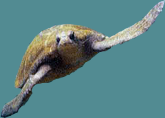Fish Populations
The monitoring of Galapagos fish populations provides an indication of the health of the marine ecosystem. The Participatory Fishing Sector Research and Monitoring Program launched by the Charles Darwin Foundation (CDF) in 1997 monitors catches, sites, and participants in fishing. Data from nearly 20,000 fishing sites were reported between 1997 and 2001 (Galapagos Islands Project, 2003). From these sites, more than 100 marine species were monitored and detailed information was obtained on commercial species, such as sea cucumbers and lobsters. Monitoring of other species caught for local consumption such as octopus and snails started in 2002. This monitoring effort has great potential, and can be strengthened through the use of GPS tracking devices on all boats in Galapagos waters (see below). This tracking system will provide supporting evidence for fishermen’s claims on the locations of their catches and ultimately for the data coming from this program.
Stereo imaging systems are currently still under development, their goal being the creation of a system for monitoring fish populations that is more accurate than fish catches or divers. Stereo imaging provides three dimensional pictures of fish, with some disadvantages being the approximate sizes and shapes of the target species must be identified ahead of time, along with the human involvement in analyzing the resulting images. This technique could be a viable option in the future.
[top]
GPS Tracking
A vessel monitoring program for the Galapagos would be beneficial. This has been successfully employed in the Sea of Cortez, Hawaii, and Chile, among other locations. The proposed system involves the attachment of Global Positioning System (GPS) devices to every boat in the Galapagos – whether fishing, tourist, or municipal, which will allow for monitoring of boat traffic in the waters of the marine reserve. The tracking devices will be securely fastened to boat hulls. These trackers will be provided by the scientist subcomittee of the Biopreserve. Patrol vessels will be equipped with GPS tracking screens to monitor the location of surrounding boats.
Harsh penalties will be inflicted on any boats found not to have a GPS tracker, such as fines and a suspension from marine activity for the individuals involved. The purpose of GPS tracking is to enforce marine boundary restrictions, and also to monitor suspicious activity that could indicate illegal fishing.
The ships will transmit their location via satellite to the Puerto Ayora monitoring station at least once per hour. This tracking method is relatively inexpensive. In the Sea of Cortez monitoring system, one employee monitors up to 500 boats for about $1.00 per day per boat, totaling one percent of the cost of aerial or marine surveillance.
[top]
Copyright! All rights reserved.
Webmasters

